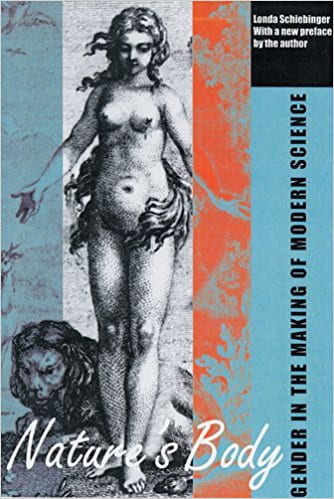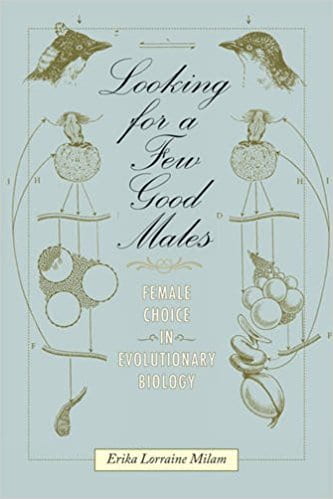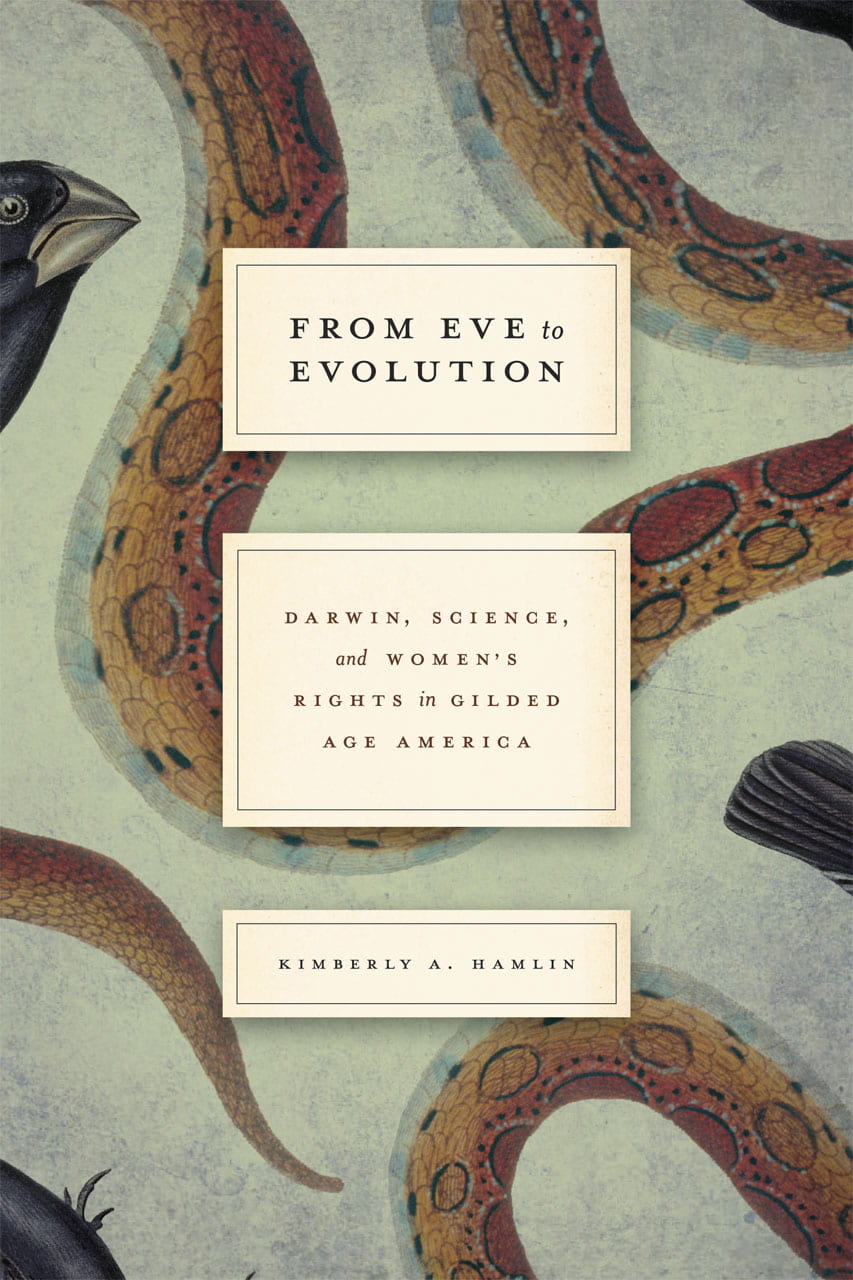By Contributing Editor Nuala F. Caomhánach
Kimberly A. Hamlin. From Eve to Evolution: Darwin, Science, and Women’s Rights in Gilded Age America. Chicago and London: The University of Chicago Press, 2014.
Erika Lorraine Milam. Looking for a Few Good Males: Female Choice in Evolutionary Biology. Animals, History, Culture. Baltimore: The Johns Hopkins University Press, 2010.
Londa Schiebinger. Nature’s Body: Gender in the Making of Modern Science. New Brunswick: Rutgers University Press, 2004.
Although women were excluded from the biological sciences, women were very much on the minds and the scientific research of the men who excluded them. The three books under review explore gender and natural history in eighteenth- and nineteenth-century American and European society. I argue that the books form a triad of analytically distinct interlocking pieces about the construction of sexual difference as a means of excluding women from the public sphere and science. The authors use the categories of science, class and gender, not because they perceive them as natural, but because they recognize that these categories form lines of historical power. Hamlin’s From Eve to Evolution: Darwin, Science, and Women’s Rights in Gilded Age America (2014) examines how American feminists responded to and integrated Charles Darwin’s evolutionary theory in Gilded Age America. Milam’s Looking for a Few Good Males: Female Choice in Evolutionary Biology (2010) presents the history of post-Darwin biological research on the concept of female choice, showing how men were mediators between biology as a body of knowledge and society. Schiebinger’s Nature’s Body: Gender in the Making of Modern Science explores how the gender-binary has molded biology since the eighteenth century. This triad demonstrates how science reinforced the binary of gender and created associated traits, how science is not external to culture but forms a symbiotic relationship that reflects societal and political order, and how biology “is not value neutral but participates in and continues to support scientific knowledge that is highly gendered” (Schiebinger x).
Sexual Difference and the Rank of Woman

Londa Schiebinger, Nature’s Body: Gender in the Making of Modern Science (New Brunswick, 2004).
Schiebinger argues that “scientific sexism” (xi), related to the concepts of the masculine and feminine, co-evolved with the emergence of modern biology. She shows the roots of sexual difference as being created by elite men who “read nature through the lens of social relations” (17). When Hamlin’s Darwinian feminists challenged, and Milam’s (male) biologists tackled this sexual difference, they provide additional support for Schiebinger’s argument that the gender binary had become fully ingrained into society. Schiebinger explains how Linnaeus’s Systema naturae (1735) created a hierarchical system of the natural world. Although contemporary naturalists recognized his scheme being artificial, he placed female traits (pistils) into the rank of order and male traits (stamens) into the rank of class. In the “taxonomic tree of life”, order was subordinate to class (Schiebinger 17). In taxonomy, traits mattered; Linnaeus prioritized male traits for identification. Schiebinger argues that Linnaeus had “ no empirical justification” (17) for this decision and here lay the origins of gendering science.
For Hamlin, the Bible created the gender binary. Hamlin argues that the biblical creation narrative, for Darwinian feminists, such as Elizabeth Cady Stanton, was “the single most powerful barrier to female equality” (49). The legacy of Eve had shaped conceptions of womanhood. When Darwin’s On the Origin of Species (1859) and The Descent of Man (1871) were published, these texts enabled woman’s rights activists to upend traditional ideas about gender roles. Hamlin shows how Darwin’s Origin provided the ideal “ballast” to fight this legacy by offering an alternative narrative of human origins (52). This new theory enabled woman’s rights activists to use objective science to subvert the assumptions that women were created from Adam’s rib and, therefore, subordinate to men.

Erika Lorraine Milam, Looking for a Few Good Males: Female Choice in Evolutionary Biology (Baltimore, 2010).
Milam argues that Darwin’s sexual selection theory was “built on his assumptions about normative relations between men and women” (10). Darwin argued that the “psychological continuity of all animal life” proved sexual difference and supplied the reason why women were intellectually inferior to men (Milam 11). Darwin applied Victorian gender roles to nature, suggesting that females were “less eager” to mate and acted “coy” and “passive” to the aggressive, hypersexualised male (Milam 15). As males competed for females, females chose males. This implied a “rational choice-based behaviour” (1) of aesthetics which required an intelligent mind and “in such cerebral evaluations lay the problem” (15). Biologists were hesitant to ascribe to animal minds this cognitive ability and reframed female choice as a reaction to male dominance. The female body, thus, became the site of analysis.
Animal-Human Kinship and the Female Body
Schiebinger demonstrates how the masculine morphology in humans became representative of the normal form and the feminine an anomaly. Linnaeus delimited hairy, lactating quadrupeds as being mammals (Mammalia); at first this seems to invert Schiebinger’s argument but she shows how this descriptor did not elevate the feminine. It was a patriarchal lesson for women to return to their natural functions, such as breastfeeding and motherhood. As naturalists became obsessed with the primate order— Linnaeus coined the term “primates,” meaning “of the first rank,” in 1758 (Schiebinger 78)—they reinforced notions of sexual difference along the animal-human continuum. Schiebinger argues that a focus on female primates’ primary and secondary characteristics advanced the masculine form as rational and intellectually superior. Milam explains that the biologist’s model of the female assumed they were naturally passive and always “needed stimulation to persuade them to mate” (34). Biologists never questioned the male-female binary. The research of scientists Vernon Kellogg, Julian Huxley, and the Fisher-Haldane-Wright triumvirate rarely focused on female choice because they felt that Darwin’s natural selection theory sufficiently explained female-male interactions.

Kimberly A. Hamlin, From Eve to Evolution: Darwin, Science, and Women’s Rights in Gilded Age America (Chicago, 2014)
Hamlin explains how this animal-human kinship model supported Darwinian feminists’ demand for the equitable division of household labor, “fit pregnancy” (98), and ability to work outside the home because gendered differences did not characterize the animal kingdom. Hamlin shows how Charlotte Perkins Gilman and Antoinette Brown Blackwell declared the separate-spheres ideology a man-made construct. When Darwinian feminists argued that women as mothers could improve the genetic stock of the human species, it became a powerful tool for women to claim a natural right to reproductive autonomy. Hamlin notes that Margaret Sanger’s fight for autonomy over the female body and her birth control movement was shaped by these popular discussions. Milam shows how biology was intrinsically at odds with popular discussions of evolutionary theory. Biologists and physiologists struggled to frame female choice, and thus they dismissed it as a viable mechanism in nature because females were limited in cognitive ability.
Science as a Male Pursuit
Hamlin shows how science became an “unwitting ally” (17) for Darwinian feminists and states that it metamorphosed into a “sexist science” as it increasingly “professionalized and masculinized” (59). Schiebinger, however, finds that science was always exclusionary. Schiebinger shows that botany was considered suitable for upper-class women, but they did not have the ability to shape biology. Hamlin argues that women did shape science. Blackwell and Helen Hamilton Gardener tried to redefine the female “mind-body dualism” by asserting their distrust in the research findings of male scientists (59). Blackwell suggested that women needed to create the “science of feminine humanity” (60) because to study female bodies “one must turn to women themselves” (62). As science gained more cultural authority, Hamlin argues, Darwinian feminists played an active role in shaping science because they rejected biological determinism and demanded accurate research. Milam’s book provides historical evidence that biology was a male pursuit and women were always excluded.
Conclusion
These authors show that biology is not a neutral practice but emerges from complex cultural and political networks. They are impressive books that shed light on the development of modern biology and the popularization of evolutionary science by dethroning notions of objectivity in science, providing a significant contribution to gender and science studies.



March 26, 2018 at 8:40 am
thank you for putting this together…topical and useful in my domains of interest ..